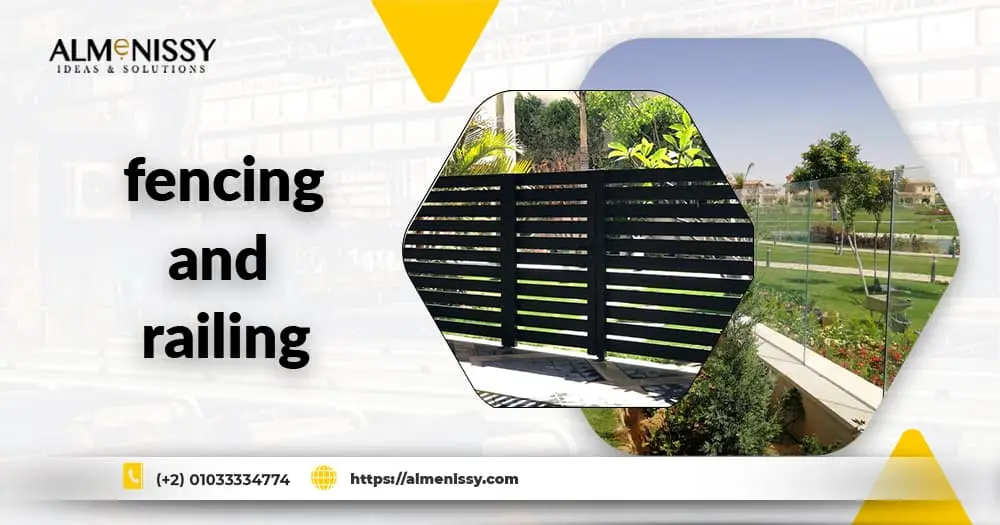Fencing and railing are essential elements in both residential and commercial properties, serving multiple purposes that go beyond mere aesthetics. These structures provide security, privacy, and safety, while also enhancing the visual appeal and defining the boundaries of spaces. Fencing can range from traditional wooden pickets and wrought iron designs to modern vinyl and composite materials, each offering unique benefits and styles.
Similarly, railings, which are often used on staircases, balconies, decks, and porches, come in a variety of materials such as metal, wood, glass, and cable, providing necessary support and preventing accidents. Together, fencing and railing play a crucial role in property design and functionality, contributing to the overall value and usability of the space.
Table of Contents
What are fencing and railing used for
fencing and railing serve various essential functions in both residential and commercial settings:
- Security: fencing and railing help protect properties from intruders and provide a sense of safety by clearly defining property boundaries and restricting unauthorized access.
- Privacy: fencing and railing create secluded spaces by blocking the view from outside, which is particularly important in residential areas for personal and family privacy.
- Safety: Railings are crucial for preventing accidents and falls, especially on staircases, balconies, decks, and porches. They provide support and stability for people navigating these areas.
- Aesthetic Appeal: Both fencing and railing enhance the visual appeal of a property. They can be designed to complement architectural styles and landscaping, adding to the overall attractiveness and curb appeal.
- Boundary Definition: Fences clearly mark property lines, helping to avoid disputes with neighbors and define spaces within larger areas, such as gardens, pools, and yards.
- Containment: They are used to contain pets and children within safe areas, providing a secure environment for them to play and move around without supervision.
- Noise Reduction: Certain types of fencing, such as solid wood or vinyl, can help reduce noise from busy streets or neighboring properties, contributing to a more peaceful living environment.
- Wind and Weather Protection: Fences can act as windbreaks, providing shelter from strong winds and harsh weather conditions, which is beneficial for gardens and outdoor living spaces.
4 Types of aluminum fences
Speaking about fencing and railing. Aluminum fences come in various styles, each offering unique benefits and aesthetic appeal. Here are four common types of aluminum fences:
1. Flat top aluminum fences:
These fences feature horizontal rails at the top and bottom, providing a sleek and modern appearance. They are ideal for both residential and commercial properties, offering a clean and unobtrusive look that can complement various architectural styles.
2. Spear top aluminum fences:
Characterized by pointed pickets extending above the top rail, spear top fences provide an added layer of security and a classic, decorative appeal. The spear design can deter climbing, making them a popular choice for security-conscious property owners.
3. Pressed point aluminum fences:
Similar to spear top fences, pressed point fences feature pickets with pointed tops that are either straight or staggered. These fences combine security with aesthetic elegance and are often used for residential properties that require a traditional look with enhanced protection.
4. Two or three-rail aluminum fences:
These fences have either two or three horizontal rails with evenly spaced vertical pickets. They are versatile and can be customized with various top styles, including flat or arched tops, to suit different design preferences. This type of fence is often used for delineating property boundaries while maintaining an open and inviting appearance.
Types of aluminum railing for decks
In addition to fencing and railing. Aluminum railings for decks come in several styles, each offering distinct benefits and aesthetic options. Here are some common types:
1. Standard picket railings:
These railings feature vertical pickets spaced evenly along the railing, providing a classic and traditional look. They offer safety and are effective at preventing falls, making them a popular choice for residential decks.
2. Cable railings:
Cable railings use horizontal or vertical stainless steel cables instead of traditional pickets. This style provides a modern, sleek appearance and maintains clear sightlines, making it ideal for decks with scenic views.
3. Glass panel railings:
These railings incorporate glass panels instead of pickets or cables. They provide a contemporary, unobstructed view while ensuring safety. Glass panels can be clear, tinted, or frosted, adding to the design versatility.
4. Horizontal bar railings:
Horizontal bar railings feature horizontal aluminum bars instead of vertical pickets. This design gives a modern, streamlined look and is often used in contemporary and urban deck designs.
5. Mesh or screen railings:
These railings use metal mesh or screen panels, offering a unique and industrial look. They provide safety and can also prevent small pets from slipping through the rails.
6. Custom design railings:
Custom aluminum railings can be designed to match specific architectural styles or personal preferences. These can include ornate patterns, custom colors, and unique shapes to complement the overall design of the deck and property.
Conclusion
In conclusion, fencing and railing are integral components of both residential and commercial properties, offering critical benefits that encompass security, privacy, safety, and aesthetic appeal. According to almenissy company, the diverse range of materials and designs available allows property owners to choose solutions that best meet their functional needs and stylistic preferences.
By carefully selecting and maintaining these structures, property owners can significantly enhance the value, usability, and overall attractiveness of their spaces, ensuring they meet both practical requirements and personal tastes. Whether for protecting boundaries, enhancing architectural features, or providing essential safety measures, fencing and railing remain indispensable elements in modern property development and maintenance.
FAQ
What are the importance of fencing and railing?
fencing and railing are vital for both residential and commercial properties due to their multifaceted benefits. They provide essential security by deterring unauthorized access and enhancing safety by preventing falls and accidents on staircases and elevated areas. Fencing ensures privacy, allowing occupants to enjoy outdoor spaces without intrusion. Both elements significantly boost the aesthetic appeal of properties, complementing architectural styles and increasing curb appeal.
What is the difference between fencing and railing?
fencing and railing serve distinct purposes and are used in different contexts, despite both being structural barriers. Fencing is primarily used to enclose areas, provide security, and ensure privacy by marking property boundaries and creating defined spaces such as yards, gardens, or pools. Railing, on the other hand, is typically used for safety and support on elevated surfaces like staircases, balconies, decks, and porches. Railings prevent falls and provide stability, often featuring handrails and infill components like balusters, cables, or glass panels.


